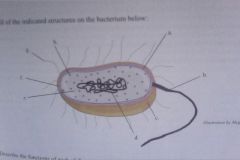![]()
![]()
![]()
Use LEFT and RIGHT arrow keys to navigate between flashcards;
Use UP and DOWN arrow keys to flip the card;
H to show hint;
A reads text to speech;
31 Cards in this Set
- Front
- Back
|
Pathogen |
Organisms that cause disease |
|
|
Saprophyte |
An organism that feeds on dead matter |
|
|
Parasite |
An organism that feeds on a living host |
|
|
Aerobic Organism |
An organism that requires oxygen |
|
|
Anaerobic organism |
An organism that does not require oxygen |
|
|
Steady State |
State in which population dies as quickly as new organisms are born. |
|
|
Exponential growth |
Population growth unhindered because abundance of resources. |
|
|
Logistical Growth |
Population growth controlled by limited resources |
|
|
Conjugation |
Temporary union of two organisms for DNA Transfer |
|
|
Plasmid |
A small circular section of extra DNA that converse one or more traits to a bacterium and can be reproduced separately from the main genetic code. |
|
|
Transformation |
Getting DNA from dead bacteria |
|
|
Transduction |
A virus transferring from one bacteria to another |
|
|
Strains |
Organisms from the same species but different traits |
|
|
Endospore |
DNA and Essential Parts of Bacteria coated with several hard layers |
|

Label all of the indicated structures on the bacterium below |
A: Plasma membrane B. Flagellum C. Capsule D. DNA E. Cytoplasm F. Cell wall G. Fimbria H. Ribosome |
|
|
Describe the functions of the following: A: Plasma membrane B. Flagellum C. Capsule D. DNA E. Cytoplasm F. Cell wall G. Fimbria H. Ribosome |
A. Filters what can come into cell. B. Locomotion. C. Protective Layer D. Information E. Supports DNA and Ribosomes F. Shape, regulates water absorption G. Used for grasping H. Chemical Factories |
|
|
What is the most popular means by which bacteria obtain food |
Saprophyte — Dead Matter |
|
|
If a bacterium is parasitic, is it heterotrophic or autotrophic? |
Heterotrophic |
|
|
List the basic steps in asexual reproduction among bacteria |
1. DNA attached to point on membrane 2. DNA is copied, copy is attached close to original 3. Cell wall elongates, separating two strands of DNA 4. New cell wall material and plasma membrane begin to grow, closing strands off from each other. 5. They make two separate cells. |
|
|
A sample of food is dehydrated, which kills all of the bacteria. However, in a few days, bacteria-free water is added to the food in a bacteria-free environment. Nevertheless, microscopic investigations indicate that bacteria are in the food. How did the bacteria get there? |
They used endospores, and were in there all along. |
|
|
What kind of growth does a population of bacteria experience when just a few of them are placed in an environment rich with resources? |
Exponential Growth |
|
|
A population experiences logistic growth. What can you say about the resources of their environment? |
Limited |
|
|
Even though genetic recombination among bacteria does not result in offspring, it can significantly affect the growth of the population. Why? |
It offers them the ability to live in situations in which they normally wouldn't be able to. |
|
|
What are the technical names of three common bacterial shapes? |
Cocci — Sphere Bacillus — Rod Spirilla — Spiral |
|
|
A bacterium lives in boiling hot water. To what phylum and class does it belong? (Page 55) |
Phylum Mendosicutes Class Archaebacteria |
|
|
A bacterium is heterotrophic and gram-negative. To what phylum and class does it belong? (Page 55) |
Phylum Gracillicutes Class Scotobacteria |
|
|
A spirillum bacteria is gram-positive. To what phylum and class does it belong? |
Phylum Firmicutes Class Thallobacteria |
|
|
A bacteria has no cell wall. To what phylum and class does it belong? |
Phylum Tenericutes Class Mollicutes |
|
|
In the six-kingdom classification system, what replaces Monera? |
Archae and Eukarya |
|
|
What conditions are ideal for most bacteria to grow and reproduce. |
Moisture, food, temperature, and proper lighting. |
|
|
What methods exist for reducing the chance of bacterial contamination of food. |
Removing moisture, heating it, cooling it. |

